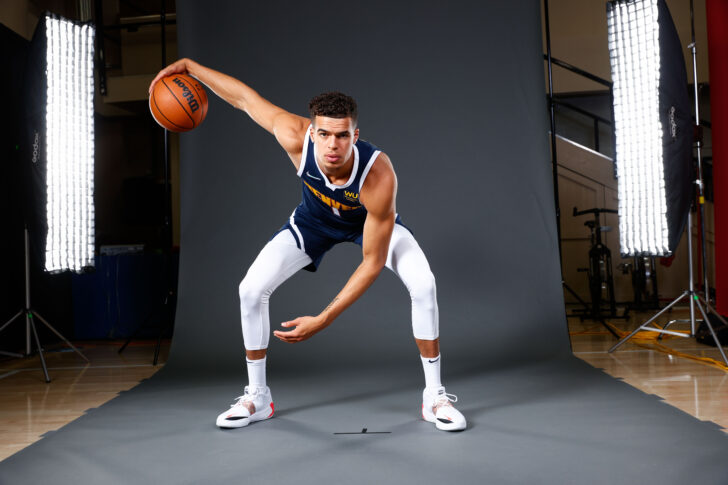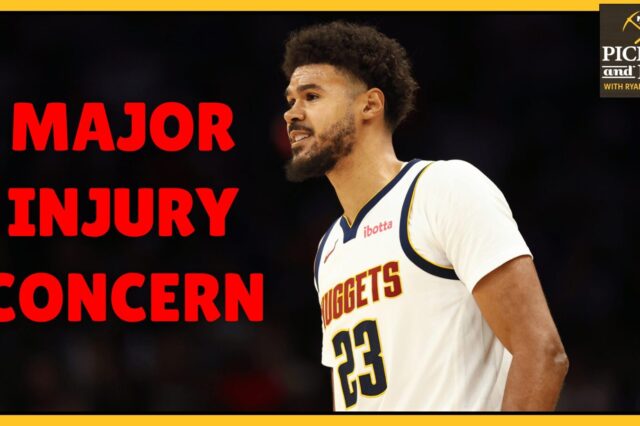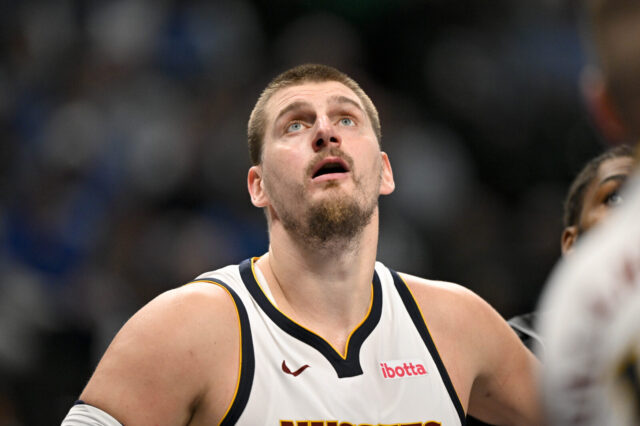Editor’s note: The following story is from the Hockey & Hoops issue of Mile High Sports Magazine. Click here to read the full digital issue.
Has there ever been a more enigmatic Denver Nugget than Michael Porter Jr.?
Before answering, take pause. The question is not asked to produce a quick, indisputable conclusion. Let’s face it, the Denver Nuggets have a long and rich history of employing, well, enigmas.
Going all the way back to the days of David Thompson, an incredible talent whose career might not have been as spectacular as it could have been because of off-court problems, and through generations of future Nuggets – Mo Martin, Chris Jackson turned Mahmoud Abul-Rauf, Antonio McDyess, LaPhonso Ellis, Kenyon Martin, Chris “Birdman” Andersen, J.R. Smith, JaVale McGee, Gary Harris – it’s a long list of peculiar players generally possessing boatloads of upside and expectation, some of which was realized, some of which was not.
Where – or if – the 23-year-old Michael Porter Jr. eventually belongs on that list is not only the thesis of this story, but perhaps the crux of the season that lies ahead. Putting him on any list just yet – he’s only played two full seasons of basketball since high school – is likely premature. Just who exactly Michael Porter Jr. is, and what he becomes, will determine whether this title-seeking iteration of the Denver Nuggets is a contender or a pretender. And not just for this season, but – ideally – many to come.
What makes Porter Jr.’s status as an enigma so very interesting all of a sudden, however, is his number.
Not the No. 1 on his jersey, the one at the end of his brand-new contract.
$207,000,000.00.
Gulp.
Denver’s favorite Uncle Stan (as in Kroenke) rarely bites the bullet with such ferocity. But the signing of Porter Jr. is anything but cheap. In fact, over the past three years, Nuggets president of basketball operations Tim Connelly has been busily and diligently opening up the checkbook and constructing Denver’s “big four” – a quarter that should have the Nuggets in contention for the next four seasons.
In June of 2018, Nikola Jokic (who rapidly ascended to NBA MVP status last season) was inked to a 5-year, $148 million max contract.
The next summer, Jamal Murray was given the same treatment – five years, $170 million.
And after working a trade that gave the Nuggets a “big four” heading into the 2021 playoffs (prior to Murray’s ACL injury) by bringing Orlando defensive stalwart Aaron Gordon to Denver, the Nuggets ponied up after the season by doubling down on Gordon, too. In September, he signed a 4-year extension to the tune of $92 million.
The word “rarely” is important when it comes to defining the typical business practices of the Kroenke Family – because “never” is patently false. The current project feels “frequent,” but it should be looked at a single event, an expensive four-player project that now looks complete. It’s not always like this; the Nuggets don’t consistently field a contending core. Over the years, however, the Nuggets will, on occasion, break the bank, go all in and spend aggressively. Recall the names that were inked to play alongside Carmelo Anthony, a legitimate NBA superstar who cost a pretty penny in his own right. Kenyon Martin, Andre Miller, Allen Iverson, Chauncey Billups, JaVale McGee (the first time) and even George Karl – all highly-compensated individuals brought in with hopes of creating the Nuggets first NBA championship.
And that’s the good news. If and when the Nuggets shove all their chips into the center of the table, it means that a title run is within sight – or at least they genuinely feel that way internally. In general, the Kroenke Family doesn’t make a habit of chasing good money after bad, but when there’s a legitimate opportunity at hand, the spending has typically followed. It’s one thing when deprived fans of the Nuggets long for a championship on an annual basis; it’s quite another when the man writing the checks believes the potential to win one exists. Clearly, there’s belief within Kroenke’s inner circles at the moment.
Again, that’s the good news.
There’s really no “bad news” to follow. There are – with regard to Michael Porter Jr. and the massive financial commitment the Nuggets have just made – some unknowns. The Nuggets know something special exists within their latest monster signing. But what’s unknown is “What happens next?”
And that’s nothing new when it comes to “MPJ,” the Nuggets newest enigma.
The talent is there. It has been from the very beginning. Max contracts are not given to hard-working contributors. Indisputable talent is an absolute requirement to haul in the biggest of bags in the NBA.
Porter Jr.’s talent has been a topic of discussion within basketball circles for as long as anyone’s known his name. As a prep at Father Tolton Regional Catholic High School in Missouri, he led his team to the Class 2A state championship as a junior. He was so good he was invited to play in the prestigious Nike Elite Youth Basketball League, a feeder system for Division I locks and NBA hopefuls. There he won a league championship and was named Nike’s Co-MVP alongside Trae Young.
At this point, his name was already being included with the next generation of soon to be NBA players. And when he followed his father to Washington, where Michael Porter Sr. had been hired on as an assistant at the University of Washington, Junior didn’t disappoint at Seattle’s Nathan Hale High School. There he averaged 36.2 points and 13.6 rebounds en route to an undefeated state championship season and an eventual McDonald’s All-American Game MVP.
Porter Jr. was set to be a classic “one-and-done,” just biding his time at the University of Missouri before becoming the first pick of the 2018 NBA Draft, or so it was regularly speculated.
But Porter Jr.’s trajectory has been anything but steady and upward. Bumps in the road are as common as his jump shot finding nothing but net.
With great hype surrounding him, Porter Jr.’s first game at Missouri was short lived, as he was injured in the first half – a back injury that would require surgery, keep him sidelined for all but a few postseason games and would soon define his early career in the NBA.
Despite the talent that was so apparent as a prep star, NBA executives across the league cooled significantly on Porter Jr. No longer was he an obvious lottery pick; instead, with a medical diagnosis that was less than encouraging, he was suddenly a risky proposition.
So, when he fell to the Denver Nuggets at No. 14, Tim Connelly simply – and wisely – couldn’t resist. The Nuggets had just landed a lottery pick midway through the first round. In Denver, there was an instant surge of excitement…
…followed by a rookie year that included troublesome additional back surgeries and zero games played. Yet, coming out of (then) Pepsi Center, there was a steady flow of murmurs as to how unbelievably good the Nuggets young star looked in workouts and practices.
With great anticipation, he was finally ready to play in the 2019 NBA Summer League. But the basketball world would once again have to wait, as Porter Jr. suffered a knee sprain that kept him sidelined until the preseason in October. During his rehabilitation, he’d also developed “drop foot,” adding to the notion that he’d never be “quite right” after all. From the get-go, the organization was extremely patient – some felt overly cautious – with their delicate prodigy but defining Porter Jr. was becoming an unnerving balance of his massive upside and a growing list of injury concerns.
When he finally played in his first regular season NBA game, after failing to make an appearance in the Nuggets first four games, he lived up to all the hype that had surrounded him since high school. On 5-of-8 shooting, Porter Jr. rained in 15 points in his first 20 minutes as a pro.
The roller coaster that had defined his basketball life was far from stopped, however. For every up, a down was sure to follow.
Early in his “actual” rookie year, Porter Jr. would dazzle with nights of deft shooting, then disappear seemingly at the whim of head coach Michael Malone. There was rampant speculation. Were the Nuggets still carefully monitoring his workload and physical condition? Was Malone feeding his young star a steady diet of humble pie? Was Porter Jr.’s treatment – tough love and a quick benching for every defensive blunder – the right way to bring him along or the quickest and surest way to break him? Monster games, like the 25 points he poured against the Pacers on 11-of-12 shooting in just 22 minutes, were followed by head-scratching substitutions and limited minutes. Directly following the Pacers game, Malone’s sharpshooter was only given 12 minutes against the Wizards, despite the fact he was an efficient 3-of-5 from the floor.
And so it went. Twenty minutes would often be followed by 10. Sometimes after a bad game, Porter Jr. would be benched for the entire next game. In the 10 games that led up to the NBA’s shutdown due to a global pandemic, Porter Jr. logged minutes in an unpredictable, disheartening pattern: 7:41, 9:42, 22:29, 9:28, 19:10, 13:29, DNP, 15:45, 11:54 and a mere 4:44 in the final game preceding the shutdown. The immediate future of the NBA was up in the air, and so was Porter Jr.’s status as a Nugget.
Anyone could see the talent and upside. Still, there was something amiss. Porter Jr. wasn’t particularly good on defense, but he was also playing the first full season of basketball since his senior year of high school. Fans griped at Malone’s apparent lack of grace.
When play finally resumed in The Bubble in August, Porter Jr. appeared to be back in good graces. To some extent, Malone was forced to play his youngster, as Will Barton was unavailable, nursing an injury of his own. Before the Bubble’s postseason, Porter Jr. played an average of just over 33 minutes per game.
And he went on a tear. During that seven-game stretch, Porter Jr. averaged 22 points, including two games of 30 and 37 points. He also looked like the team’s best rebounder, cleaning the glass to the tune of 8.6 rebounds per game – an impressive stretch that saw four double-doubles for Porter Jr.
For the most part, Malone’s faith in Porter Jr. remained steady once the playoffs began, and Porter Jr. responded admirably; Will Barton was still conspicuously absent from The Bubble.
Naturally, when the 2020-21 season commenced, it felt as if Porter Jr. had cleared the hurdle, that he would now be a steady piece of the Nuggets puzzle.
With his minutes having leveled out, averaging 31 minutes per game (up from 16:40 as a rookie), Porter Jr. rewarded the Nuggets for his increased workload, averaging 19 points and 7.3 rebounds. More impressive were his shooting percentages of 53 from the floor and 44 from beyond the 3-point arc. Malone still had the occasional complaint about Porter Jr.’s defense – an area in which he’ll still need to improve – but by and large it seemed that the second-year Nugget had turned the corner.
In the first round of the playoffs, that belief was further validated. He was instrumental in advancing past Portland, especially considering Jamal Murray wouldn’t be playing in the postseason at all. In the opening game, Porter Jr. slapped Portland for 25 points, and in games 5 and 6, he helped put the nail in the coffin with 26 and 26 respectively.
In Round 2 against the eventual conference champ Phoenix Suns, he cooled off slightly, a development many attributed to injury. Still, he averaged 15.3 points and 5.5 rebounds, as the Nuggets were swept by the Suns.
With free agency in front of him, and 10 months that saw leaps and bounds of development behind him, Tim Connelley had apparently seen enough to bet big on Porter Jr.
Really big.
No sooner than the ink had dried on his massive new contract, however, the trials and tribulations of Michael Porter Jr. continued. As if to keep things interesting, Porter Jr. publicly stated that he would join the list of NBA players who would not being getting a COVID-19 vaccination shot. With health and safety guidelines of the NBA and the cities in which it plays hanging in the balance, it’s difficult to say what kind of impact this decision will have on Porter Jr. or, more importantly, the team that just handed him almost a quarter of a billion bucks.
At every turn, it seems that Porter Jr.’s basketball life is an ever-evolving risk-return equation. The Nuggets took a huge risk, not it’s time for their return.
Will Michael Porter Jr. become an integral member of Denver’s “big four,” essentially the missing piece to the ever-elusive NBA title the Nuggets so desperately seek? Or will he be added to the long list of enigmatic players throughout Nuggets history – talents that entertained and enticed us, but ultimately failed to reach greatness.
The talent is there. His resume now shows real and tangible results. And still just a 23-year-old baby, even his upside is wildly enchanting. But the one thing that’s always in question when it comes to Michael Porter Jr., is the future.
The Nuggets just bet big that it will be blindingly bright.



